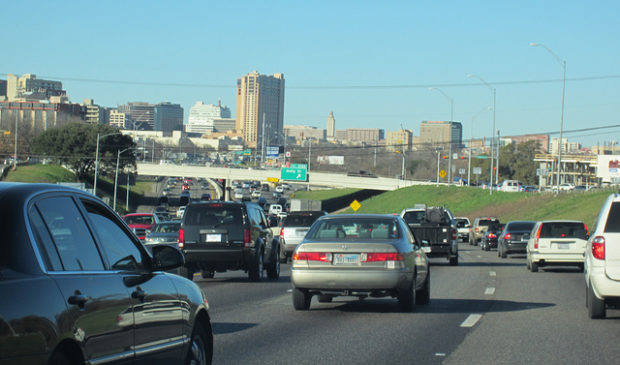Tech leaders consider autonomous vehicles, scooters and more to solve transit
Thursday, November 15, 2018 by
Chad Swiatecki For all the debate and hope over new transit plans and the potential for light rail to move Austin residents around quickly and efficiently, the city’s growing traffic and transportation problems come down to simple math. That was the point that Karla Taylor, chief of staff for Austin’s Transportation Department, made at a recent panel discussion about how the city’s technology sector can contribute to local transit improvements.
“We’ll have 3.5 million people here by 2040, and that means major delays,” Taylor told the audience gathered for the Austin Forum on Technology and Society’s November panel at Austin Central Library. “Everybody trying to go to the same place at a different time … and 75 percent of us are driving in our cars alone. That’s not sustainable, and the roadways aren’t getting any bigger.”
The table set with Taylor’s frequent reminder that it’s not possible to easily change the geometry of Austin’s roads, panelists spent the night sharing their thoughts on the possibilities and challenges inherent in the city’s growth and currently limited transportation capacity.
Autonomous vehicles were the central discussion point of the night. Questions about improving the public’s confidence in driverless cars led to debate over how quickly the city is moving to enable the technological infrastructure to make autonomous vehicles as capable and as networked as possible.
Referencing panelist Jason JonMichael, who is Austin’s assistant director of smart mobility, panelist Barry Einsig from CAVita consulting group said technology companies are waiting expectantly for the chance to build apps and other digital products tailored for the next generation of passenger cars.
“Eighty percent of safety can be solved through connectivity, and the next big piece of that is going to be like when you went from an analog flip phone to a digital smartphone,” Einsig said.
“We now have volumes of data and information about everything that we’ve never had before, and we’re going to go through that next big transformation. That’s not way off into the future. As soon as Jason bulks up and connects every traffic light in the city of Austin, things are going to go chaotic because there’s so much data available and developers will want to build new apps.”
JonMichael said the city is grappling with how to manage the large volumes of data that will come from full connectivity, and he challenged those in attendance to help improve more than two dozen existing open-source apps that target fuel efficiency, wayfinding and more.
“Cars will talk to an intersection 10 times a second and at some point I don’t need that kind of data anymore. At a certain point that begs the question of how do I send back just the data that I need?” he said.
“There are 30 apps available to deploy on intersections. All those are out there in open source for all the people in this room and all your friends who are coders, to go and download those and start making them better.”
The vast reach of auto giants such as GM and Ford gives them the ability to play a large role in the adoption of autonomous vehicles, which are expected to make up 50 percent of the auto market by 2040. Currently those automakers are targeting small initiatives to test the viability of the technology on a smaller scale.
Kathleen Baireuther, senior manager of Ford Smart Mobility in Texas, said large automakers and startups need to work together to find new transit options that will meet the needs of the public for the next generation and beyond.
“We have to create this ecosystem of options. Microtransit is one word you’ve probably heard, and if you’re a supernerd you’ve probably heard of micro-mobility,” she said. “Getting more people into a car is one option and getting them out of a car completely is another. Scooters are part of that and there’s good and bad in that, but every person on a scooter is one less car you’re sitting behind.”
Photo by Steve, made available by a Creative Commons license.
The Austin Monitor’s work is made possible by donations from the community. Though our reporting covers donors from time to time, we are careful to keep business and editorial efforts separate while maintaining transparency. A complete list of donors is available here, and our code of ethics is explained here.
You're a community leader
And we’re honored you look to us for serious, in-depth news. You know a strong community needs local and dedicated watchdog reporting. We’re here for you and that won’t change. Now will you take the powerful next step and support our nonprofit news organization?


